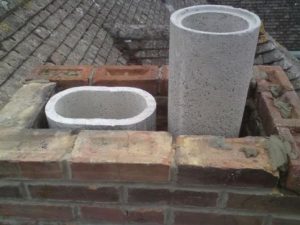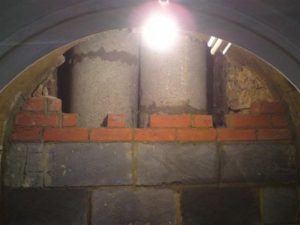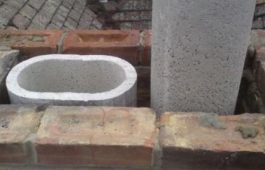Flue Lining
Flue Lining – current practice
 In recently built houses, where a fireplace is specified, the chimney structure is often brick built and then lined with clay or other liners. The size of the liners chosen at that time will determine the potential of the fireplace whether limiting it to an enclosed stove by fitting 150mm internal diameter liners or allowing a large open fire by installing say 350mm id liners for a fire opening 1metre by 1 metre. With existing environmental legislation it is difficult for architects and designers to win approval for the large open fire because it reduces the SAP scores that are central to modern planning and sustainability targets. The size of the permanent air duct into the room where the appliance is installed, a requirement of building regulations, is also determined by the size of the flue, generally it must be a minimum of 50% of the flue area.
In recently built houses, where a fireplace is specified, the chimney structure is often brick built and then lined with clay or other liners. The size of the liners chosen at that time will determine the potential of the fireplace whether limiting it to an enclosed stove by fitting 150mm internal diameter liners or allowing a large open fire by installing say 350mm id liners for a fire opening 1metre by 1 metre. With existing environmental legislation it is difficult for architects and designers to win approval for the large open fire because it reduces the SAP scores that are central to modern planning and sustainability targets. The size of the permanent air duct into the room where the appliance is installed, a requirement of building regulations, is also determined by the size of the flue, generally it must be a minimum of 50% of the flue area.
Our advice for those building new chimneys is to use the Schiedel Isokern flue liners because they have much greater insulation value than other liners and much better longevity than any steel ones. Recently we have seen various drawings for proposed new builds where twin wall steel flues are suggested. In our view this is short sighted. Where possible a new flue should be a permanent part of a building and twin wall steel flues will require replacement in time.
Relining the flue of an older property
There are two reasons for lining a flue in an established building
The first reason is that the flue leaks and there is concern that the smoke and fumes will be a danger to health in particular in upstairs rooms.
 Older flues were typically built of brick with withes (brick partitions) separating each flue on their way up the chimney stack. You may have noticed that fireplaces in upstairs rooms are often offset to accommodate the flue(s) from the lower floor as it passes by on its way to the top of the stack. Commonly, these brick flues were rendered in order to maintain a seal. Over the years this render will break down and the mortar joints can become loose. This will allow the flue to leak though, particularly with solid fuel fires, some of the soot and tar will lodge in the joints and keep the flue sufficiently sealed.
Older flues were typically built of brick with withes (brick partitions) separating each flue on their way up the chimney stack. You may have noticed that fireplaces in upstairs rooms are often offset to accommodate the flue(s) from the lower floor as it passes by on its way to the top of the stack. Commonly, these brick flues were rendered in order to maintain a seal. Over the years this render will break down and the mortar joints can become loose. This will allow the flue to leak though, particularly with solid fuel fires, some of the soot and tar will lodge in the joints and keep the flue sufficiently sealed.
From the perspective of a HETAS registered installer it almost impossible to confirm the safety of older flues that are unlined. Even using the various sealed and pressure testing methods requires an element of judgement because it is usually possible to make the flue leak and this may or may not mean it is dangerous. Where there is a good flue draft the smoke and fumes do not need to divert from the flue and so, however leaky the flue is, the impetus of the flue gases is only toward the outside atmosphere. Nevertheless, it is important to be absolutely sure that the flue is sealed and with older brick flues we will generally recommend lining for certainty and for peace of mind.
The second reason for lining a flue is that the appliance used requires a flue of a certain diameter. Typically, a free standing stove will require a 150mm internal diameter flue and, where the stove is to replace a standard 400 to 450mm (16 to 18 inches) wide open fire commonplace in many older properties, the existing brick flue will be 225mm x 225mm (9 inches by 9 inches). This means that the stove, designed to operate at its most efficient with a 150mm flue, will not work efficiently within the existing square brick flue.
 Enclosed stoves are very controllable and this is achieved through adjusting the amount of air that is arriving within the fire and leaving through the flue. These adjustments encourage or reduce the draught and rely on the correct sized flue to accept these adjustments. An efficient flue is a hot one and, with the modern stove pouring heat into the room rather than up the flue, the flue gases can be cooler than in days past with an open fire, though there is an opposing point of view that an open fire draws more air from the room and therefore has a reduced flue temperature. Nevertheless, It is essential that the flue is of a suitable size to accommodate the smoke and fumes generated and to keep the draught flowing in a concentrated manner rather than meandering up an oversized flue cooling and condensing on the way. As the flue gases cool there is a tendency for tar to form on the walls of the flue and this can restrict the flue and, more dangerously, form the fuel for a chimney fire.
Enclosed stoves are very controllable and this is achieved through adjusting the amount of air that is arriving within the fire and leaving through the flue. These adjustments encourage or reduce the draught and rely on the correct sized flue to accept these adjustments. An efficient flue is a hot one and, with the modern stove pouring heat into the room rather than up the flue, the flue gases can be cooler than in days past with an open fire, though there is an opposing point of view that an open fire draws more air from the room and therefore has a reduced flue temperature. Nevertheless, It is essential that the flue is of a suitable size to accommodate the smoke and fumes generated and to keep the draught flowing in a concentrated manner rather than meandering up an oversized flue cooling and condensing on the way. As the flue gases cool there is a tendency for tar to form on the walls of the flue and this can restrict the flue and, more dangerously, form the fuel for a chimney fire.
Even with open fires the flue size needs to be correct. As indicated above, for an open fire to burn well and not spill smoke and fumes the flue must be of sufficient size. Where the flue is well configured (tall and fairly straight) and also well insulated it can function well where the flue area is 10% of the fire opening area. For example a fire opening 1 metre by 1 metre can function well on a flue of 350mm id. The more generally accepted opinion is that a flue needs to be at least 15% of the opening dimensions and each flue and fireplace needs to be assessed individually.
The science around chimneys and flues is not an exact one. Two similarly configured flues in similar environments may operate quite differently for no apparent reason. We have recently been asked to advise on an apparently correctly built chimney on a new build. A good tall flue and with only a shallow bend in it sited well away from the fire opening. A well-made smooth and tall gather all appeared to be well judged. However, the fire spilled smoke and fumes. There was a taller structure within 15 metres of the stack but this did not appear to be the cause and the only recommendation that could be offered was to increase the height further and if that did not improve things then to lift the hearth, in effect reducing the fire opening by 100mm. In fact, a small increase in height with a taller pot has solved the problem, at least in current weather conditions.
Problems can arise for a number of reasons external to the building itself, for instance a down draught problem resulting from the natural or built environment. Air funnelling around a building can cause a vacuum as it passes air bricks and drags the air out of the building and thus the fireplace may spill. Experience will often be able to foretell the likelihood of this happening.
What type of flue liner?
Once a decision has been made to line the flue the choice of liners is wide. The most commonly used re-lining material is flexible stainless steel and this is a good HETAS approved material. The liner can usually be installed by introducing it into the flue via the top of the chimney stack. The liner is then drawn down the flue for connection via an adaptor in the newly installed register plate to the stove flue pipe and held in place at the top with a combination of top fixing components and a cowl. The cowl is particularly important with stainless steel as any water entering the flue will pass quickly into the fire place.
There are two forms of stainless steel used – 316 and 904. The latter is considered longer lasting and recommended where fossil fuels are burnt and stoves left slumbering for lengthy periods. It is more expensive than the 316 version. Along with the careful choice of steel liner it is important that good quality connectors and ancillary fixings are used. Stainless steel is a long lasting product but it will be exposed to corrosive gases and condensates and all the components in the installation need to be of similar quality. The installation of a stainless steel liner cannot be considered as a permanent solution to a leaking flue but will give you many years of useful life if swept regularly and used only with well-seasoned dry hardwood or other fuel approved by the stove manufacturer.
In our opinion, at the top end of the scale are the pumice based systems. We use the Schiedel Isokern products which are factory made and to an excellent consistency and quality. Because the liners include pumice they have a very high insulation value (much greater than stainless steel) and this  encourages a hot internal flue temperature and cool external temperature. This material makes a long lasting flue system so that the liners, surrounded by insulating leca pellets (light expanded clay aggregate) become integral to the building. Where a new chimney is being built, or an old one rebuilt, these liners can be cut at a suitable height to be fully incorporated with the lead tray. This is dressed across the whole cross sectional area of the stack and then turned up inside each flue way / pumice liner to collect and eject any water running down the inside of the flue along with any other water saturating the exposed stack and percolating downwards. This provides a significant and long term benefit to the building over and above the benefits of the flue material itself. We have another article about dealing with problems of damp in chimney breasts and the high value of correct lead work and in particular the lead tray.
encourages a hot internal flue temperature and cool external temperature. This material makes a long lasting flue system so that the liners, surrounded by insulating leca pellets (light expanded clay aggregate) become integral to the building. Where a new chimney is being built, or an old one rebuilt, these liners can be cut at a suitable height to be fully incorporated with the lead tray. This is dressed across the whole cross sectional area of the stack and then turned up inside each flue way / pumice liner to collect and eject any water running down the inside of the flue along with any other water saturating the exposed stack and percolating downwards. This provides a significant and long term benefit to the building over and above the benefits of the flue material itself. We have another article about dealing with problems of damp in chimney breasts and the high value of correct lead work and in particular the lead tray.
Cast in situ systems are popular though we do not use them. They are appealing because they can be installed in most configurations of flue way. However, it is extremely difficult to ensure that the right consistency and thickness of the material is applied, in particular, on bends where the former, the sausage shaped material that is passed down the flue to maintain the required flue dimensions, will be effected by the configuration and there is a possibility reduced application made. We have been called to remove these when they have not been well installed and there have been many examples of an insufficient depth of material and even none at all in parts of the flue. However, when well and carefully applied this can produce a safe and efficient flue but will never have the consistency of factory made lining materials.
Where the condition of the flue allows various coating systems can be applied. These rely on the existing fabric of the flue being in sufficiently good condition. We use Isokoat in these cases and we prefer to apply this by hand as far as possible. With large flues, for instance in inglenook fireplaces, a height of several metres can be reached by hand and where access is no longer possible there is the option of applying the coating using a sponge under pressure and winching this up the flue or opening up the flue at various heights and applying the coating continuously by hand.
There are other resin based linings and these also have a useful role albeit offering little insulation. They are relatively new systems and are introduced into the flue in an unexpanded form and then steam is pumped through them to expand and set the material to fit as snugly as possible into the flue. Before using this material the flue will be inspected with CCTV to ensure that the structure of the flue is sound enough to accept and support the liner. Where maintaining a large flue area is a requirement we suggest that, rather than use the resin based methods, alternative and/ or additional routes are chosen and the pumice system used.
In the search for maximum flue area to suit a larger open fire additional flue routes can be sought from adjacent unused flues. In general terms the chimney breast has the same width and depth in every floor throughout the building and on the lowest floor will hold only one flue (or perhaps two if they are back to back fireplaces). This means that there is a large volume of chimney breast that, whilst supporting the brick work above, is otherwise available to create additional flue area. Older buildings routinely had a fireplace in every room and so there is usually plenty of potential flue area. Where a flue is robbed from a higher floor that flue is routed down through the chimney breast to a suitable position above the fire place in question. The flue gather is then designed to accept both liners. This results in a long term structurally sound outcome where the flue will last as long as the rest of the building.
In conclusion a good flue is one that is close to vertical in configuration, of the correct size for the chosen appliance and one that maintains a good flue temperature on the inside without allowing that heat to transfer into other vulnerable areas of the building. This means that the flue should be well insulated for safety and efficiency. A flue that allows the fumes and smoke to cool before reaching the atmosphere will more readily form soot and tar deposits and these can cause a hazard.



